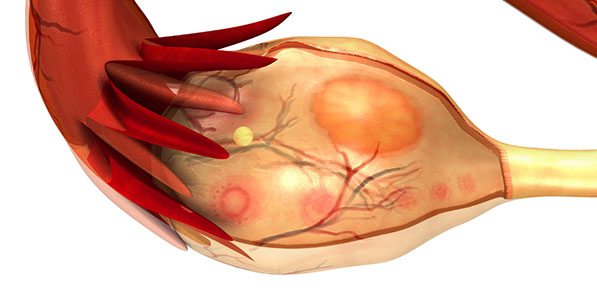A common confusion among women, is understanding the difference between having polycystic ovaries (PCO) and having been diagnosed with a Polycystic Ovarian Syndrome (PCOS).
PCO refers to an ultrasound scan image of the ovaries that appear to be polycystic (ovaries containing high density of partially mature follicles).
PCOS is a metabolic condition that may or may not come with having polycystic ovaries.In fact, to be diagnosed with PCOS a woman needs to have 2 of the following: 1) Polycystic ovaries appear on ultrasound. 2) Irregular periods. 3) Increased male hormone in the blood test or associated symptoms such as extra hair growth or acne. So if a woman has irregular periods and an increased male hormone she could have PCOS without her ovaries being polycystic. However, other conditions such as thyroid or pituitary dysfunction need to be excluded before PCOS diagnosis is made.
Although there may be some similarities in the names, the risks and medical treatments are very different for these 2 situations. PCO is a normal variant of a woman’s ovary, whereas PCOS is a diagnosed condition with short and long-term consequences. This article will outline the major differences between the two.
- PCO is more common than PCOS:
PCO is more prevalent with up to a third of women of childbearing age having polycystic ovaries on ultrasound and no other symptoms. PCOS, on the other hand, affects 12-18% of women of reproductive age, with 70% of these cases remain undiagnosed in the community. (Statistics from: www.betterhealth.vic.gov.au) - PCO is not a disease, whilst PCOS is a metabolic condition:
PCO is a variant of normal ovaries, whilst PCOS is a metabolic disorder associated with an unbalanced hormone levels released by the woman’s ovaries. - Women with PCOS are at risk of developing the associated short and long-term effects, whereas women with PCO are not:
Women with PCOS should be aware of the associated risk which may include: diabetes, pregnancy complications (ie. gestational diabetes), cardio-vascular disease, obesity and endometrial cancer. Women with PCO do not have the same risk profile. - PCOS has symptoms and is evident early in life whilst PCO has no symptoms and often discovered by chance:
Whilst both PCO and PCOS have a genetic component, PCOS often start showing symptoms (acne, excess hair growth etc.) in teen years, due to the associated metabolic disturbance. PCO may also be present early in life, but since there are no symptoms, it is discovered incidentally during other health checks when the woman is older. - Emergence of cysts in PCO may be caused by a variety of reasons as opposed to PCOS where is it linked to a hormonal disorder:
Women with PCO may still posses the hormonal balance and continue to ovulate regularly. Whilst in PCOS, the hormonal balance is distorted which interferes with ovulation. In a large proportion of these women the mechanism is linked to high insulin release that stimulates the production of androgens from the ovary disturbing ovulation. - Women with PCO can still get pregnant, whilst those with PCOS may struggle with infertility:
Conception with PCO may not be difficult, however women with PCOS may have problems getting pregnant. In addition, women with PCOS have a higher miscarriage rates.
Image credit: Bigstock.com
Note: Article sourced from: www.fertilitypharmacy.com.au.
For any inquiries, contact Dr. Polyakov on (03) 9988 4622, send an email or browse our website for a wealth of articles and patient information.
